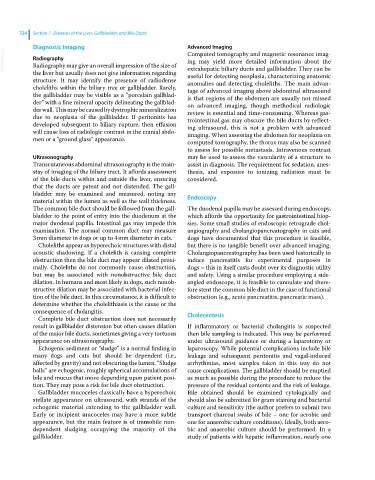Page 756 - Clinical Small Animal Internal Medicine
P. 756
724 Section 7 Diseases of the Liver, Gallbladder, and Bile Ducts
Diagnostic Imaging Advanced Imaging
VetBooks.ir Radiography ing may yield more detailed information about the
Computed tomography and magnetic resonance imag
Radiography may give an overall impression of the size of
the liver but usually does not give information regarding extrahepatic biliary ducts and gallbladder. They can be
useful for detecting neoplasia, characterizing anatomic
structure. It may identify the presence of radiodense anomalies and detecting choleliths. The main advan
choleliths within the biliary tree or gallbladder. Rarely, tage of advanced imaging above abdominal ultrasound
the gallbladder may be visible as a “porcelain gallblad is that regions of the abdomen are usually not missed
der” with a fine mineral opacity delineating the gallblad on advanced imaging, though methodical radiologic
der wall. This may be caused by dystrophic mineralization review is essential and time‐consuming. Whereas gas
due to neoplasia of the gallbladder. If peritonitis has trointestinal gas may obscure the bile ducts by reflect
developed subsequent to biliary rupture, then effusion ing ultrasound, this is not a problem with advanced
will cause loss of radiologic contrast in the cranial abdo imaging. When assessing the abdomen for neoplasia on
men or a “ground glass” appearance.
computed tomography, the thorax may also be scanned
to assess for possible metastasis. Intravenous contrast
Ultrasonography may be used to assess the vascularity of a structure to
Transcutaneous abdominal ultrasonography is the main assist in diagnosis. The requirement for sedation, anes
stay of imaging of the biliary tract. It affords assessment thesia, and exposure to ionizing radiation must be
of the bile ducts within and outside the liver, ensuring considered.
that the ducts are patent and not distended. The gall
bladder may be examined and measured, noting any Endoscopy
material within the lumen as well as the wall thickness.
The common bile duct should be followed from the gall The duodenal papilla may be assessed during endoscopy,
bladder to the point of entry into the duodenum at the which affords the opportunity for gastrointestinal biop
major duodenal papilla. Intestinal gas may impede this sies. Some small studies of endoscopic retrograde chol
examination. The normal common duct may measure angiography and cholangiopancreatography in cats and
3 mm diameter in dogs or up to 4 mm diameter in cats. dogs have documented that this procedure is feasible,
Choleliths appear as hyperechoic structures with distal but there is no tangible benefit over advanced imaging.
acoustic shadowing. If a cholelith is causing complete Cholangiopancreatography has been used historically to
obstruction then the bile duct may appear dilated proxi induce pancreatitis for experimental purposes in
mally. Choleliths do not commonly cause obstruction, dogs – this in itself casts doubt over its diagnostic utility
but may be associated with nonobstructive bile duct and safety. Using a similar procedure employing a side‐
dilation. In humans and most likely in dogs, such nonob angled endoscope, it is feasible to cannulate and there
structive dilation may be associated with bacterial infec fore stent the common bile duct in the case of functional
tion of the bile duct. In this circumstance, it is difficult to obstruction (e.g., acute pancreatitis, pancreatic mass).
determine whether the cholelithiasis is the cause or the
consequence of cholangitis. Cholecentesis
Complete bile duct obstruction does not necessarily
result in gallbladder distension but often causes dilation If inflammatory or bacterial cholangitis is suspected
of the major bile ducts, sometimes giving a very tortuous then bile sampling is indicated. This may be performed
appearance on ultrasonography. under ultrasound guidance or during a laparotomy or
Echogenic sediment or “sludge” is a normal finding in laparoscopy. While potential complications include bile
many dogs and cats but should be dependent (i.e., leakage and subsequent peritonitis and vagal‐induced
affected by gravity) and not obscuring the lumen. “Sludge arrhythmias, most samples taken in this way do not
balls” are echogenic, roughly spherical accumulations of cause complications. The gallbladder should be emptied
bile and mucus that move depending upon patient posi as much as possible during the procedure to reduce the
tion. They may pose a risk for bile duct obstruction. pressure of the residual contents and the risk of leakage.
Gallbladder mucoceles classically have a hyperechoic Bile obtained should be examined cytologically and
stellate appearance on ultrasound, with strands of the should also be submitted for gram staining and bacterial
echogenic material extending to the gallbladder wall. culture and sensitivity (the author prefers to submit two
Early or incipient mucoceles may have a more subtle transport charcoal swabs of bile – one for aerobic and
appearance, but the main feature is of immobile non one for anaerobic culture conditions). Ideally, both aero
dependent sludging occupying the majority of the bic and anaerobic culture should be performed. In a
gallbladder. study of patients with hepatic inflammation, nearly one

